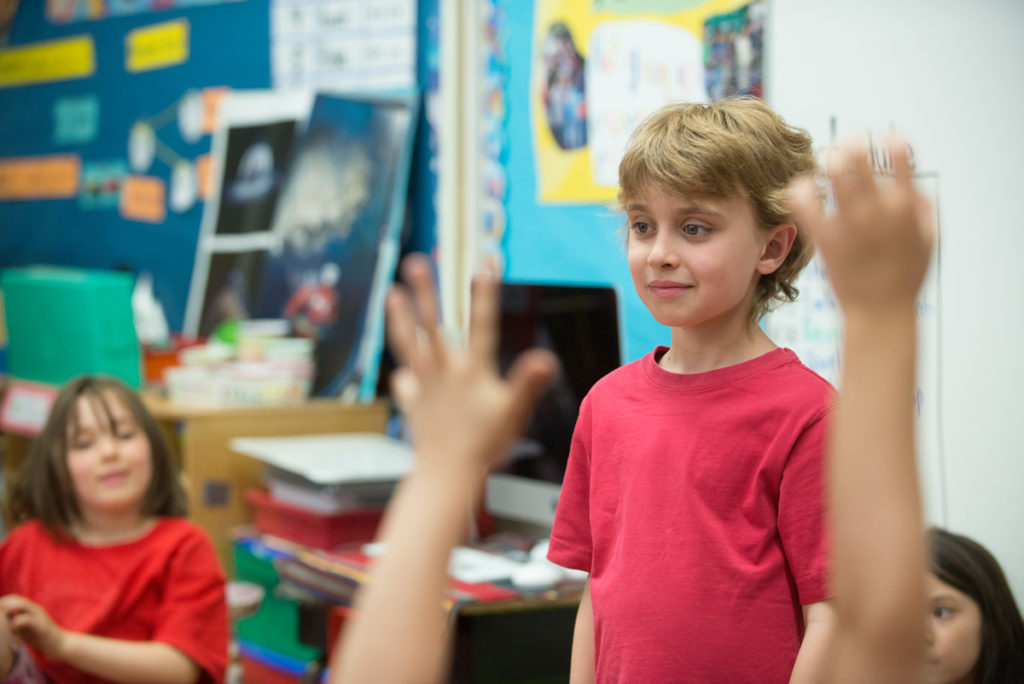
In the book The First Six Weeks of School, co-authors Paula Denton and Roxann Kriete emphasize the importance of helping students feel a sense of comfort and ownership in the classroom from the very first days of school. How do teachers do this? We asked a few to share their ideas.
I begin the year with an activity that I adapted from Patricia M. Cunningham called “King or Queen of the Day” (Phonics They Use by Patricia M. Cunningham, 2nd edition, New York: HarperCollins College Publishers, 1995). It’s an activity that helps children to get to know each other and to feel a sense of belonging and comfort in the classroom.
Each day, a child is chosen to be the “King or Queen of the Day.” The child wears a special crown and sits in a special chair in front of the group. The other children and I interview the child, asking questions about the child’s interests and life outside of school. After the interview, we look at the child’s name on a sentence strip. We notice how it’s spelled, we count the letters, we compare it to other names, we play a word game (such as unscramble the letters) using the letters from the child’s name, etc. Each child then draws a picture of something she or he learned about the king/queen and presents the picture to the king/queen. Students beam as they collect these pictures.
Finally, I take a photograph of the child, which is placed with the child’s name on a piece of poster board near our classroom entrance with a sign that reads, “The children in classroom 207 welcome you.” I often notice children standing by the photos and talking about them. If a student leaves during the year, we keep the child’s photo up to help us remember them. If a new child enters our class during the year, the children are always quick to remind me, “Ms. Stafford, don’t forget to do the ‘King/Queen of the Day.’”
Paula Stafford has been teaching first grade for seven years at Murphy School in Chicago, Illinois.
From the first day of school, the students and I work together to make the classroom belong to everyone. Throughout the year, but especially during the first two weeks, we focus on projects that make the room reflect the personalities of all its members. Here are a few of them:
Name Cards: During the first week, students make large name cards that colorfully exhibit their names, their favorite places in the world, their favorite activities, the place they were born, and a symbol that represents them. These cards help children get to know each other and can be displayed in the room. They can also be used to designate seats, choose lunch partners, greeters, etc.
Labels: During the first few days of school, students beautifully label all the areas in the room. Through this process they become familiar with the classroom and are able to express their personalities through artwork that is then permanently displayed in the room.
A Name Project: Our names and our signatures are symbols of our individuality. In this art project done at the end of the first few weeks, students write their names on a 16” × 16” square and decorate the square as they wish. The project allows for creativity and self-expression. A large display is made of all the names with a banner stating, “We are the sixers! Welcome to our class!”
Terri Kominers is a sixth grade teacher at Horace Mann Elementary School in Washington, DC. She has been teaching for eight years.
The idea for the following bulletin board display originated from a suggestion in Frank Schaffer’s School Days (Sept./Oct. 1992). On a piece of white copy paper, made into a square and divided into four sections, students share information about themselves by completing and illustrating sentence starters such as, “I am good at . . . ,” “I enjoy . . . ,” I would like to be . . . ,” etc. Students glue this paper onto the center of a paper T-shirt which they have traced and cut from a piece of 12″ × 18″ construction paper. The students then cut out the letters of their names from scraps of construction paper, which they glue across the top of the T-shirt.
With the help of our media specialist, we take a headshot photograph of each child using a digital camera. These are enlarged and printed on photo-quality inkjet paper. Finally, each child writes his/her “hopes and dreams” for the school year in a speech balloon, and students assemble the final display—with T-shirt, headshot, and speech bubble for each child—on a large, prominent bulletin board.
Gayle Heinecke, in her 25th year of teaching, currently teaches third grade at the Aquila Primary Center in St. Louis Park, Minnesota.